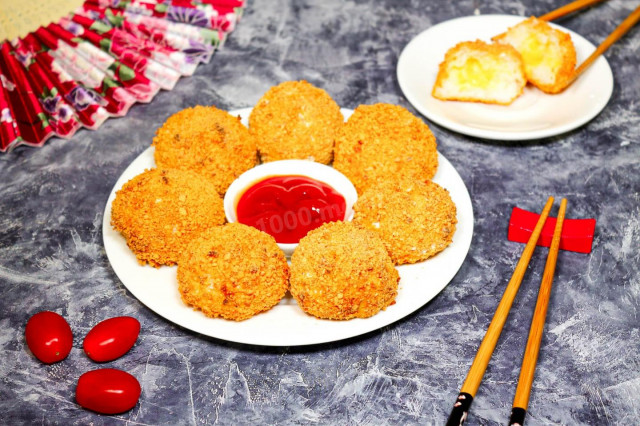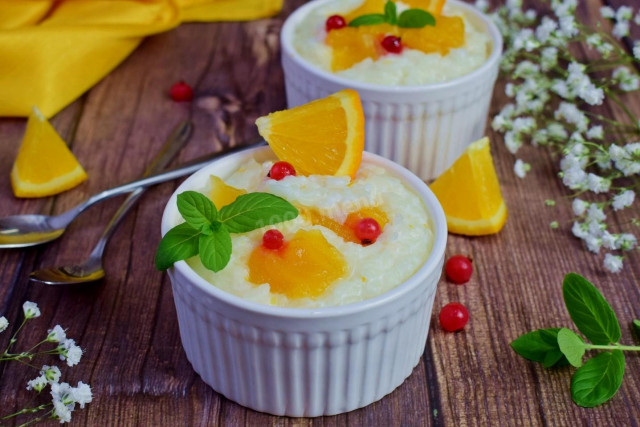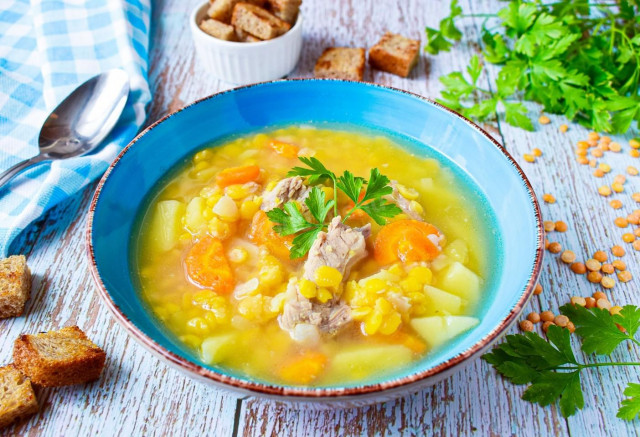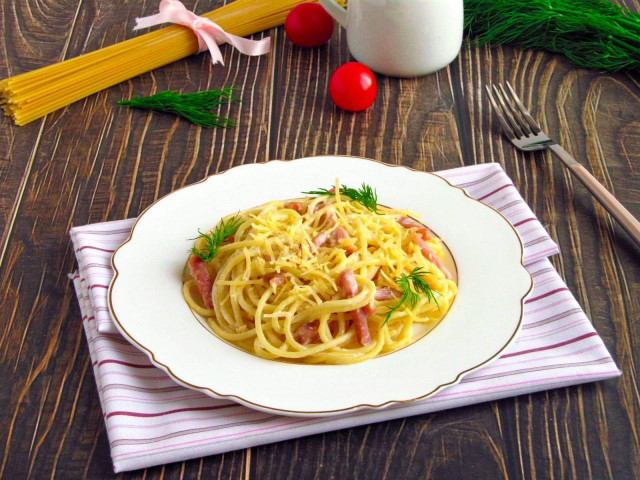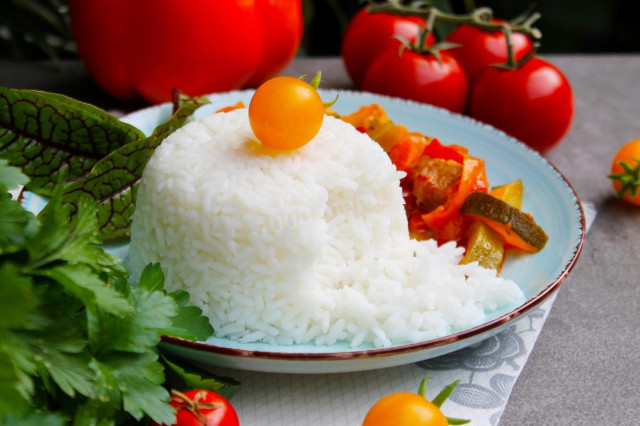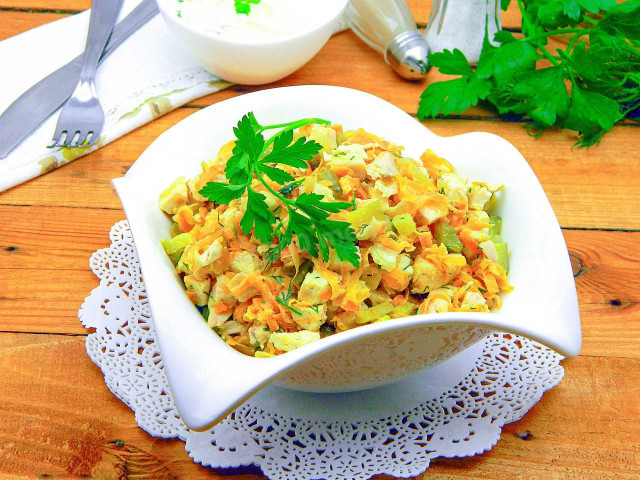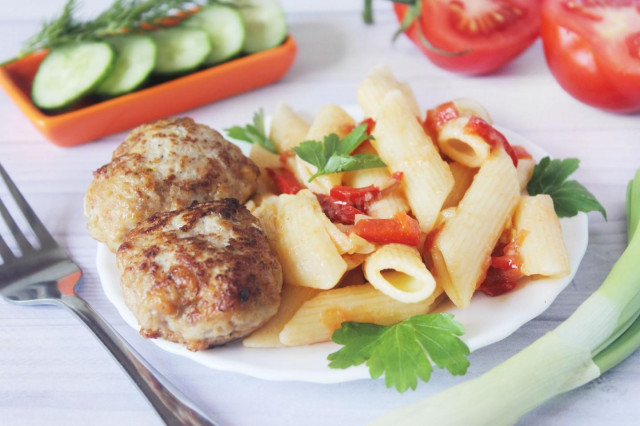Composition / ingredients
Step-by-step cooking
Step 1:
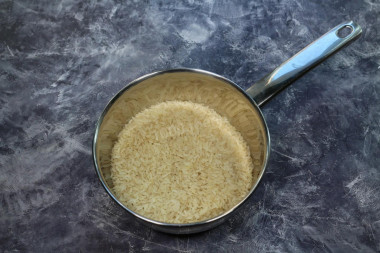
How to make Japanese rice balls with cheese? First of all, boil the rice for the balls. How to cook rice? Measure out the required amount of rice, rinse it well under the tap. Then pour water in a ratio of 1:1, add a little salt. Cook the rice in a saucepan over medium heat without a lid. The cooking time after boiling the water is 10 minutes. The water will have to be completely absorbed into the rice. Leave it to cool. Round rice is best suited.
Step 2:

Prepare the cheese filling. How to make the filling? Peel the onion and finely chop it. Garlic is also cleaned and passed through a press. Put the prepared onion and garlic in a frying pan, pour in half of the chicken broth and put the pan on a small fire. Simmer the vegetables until the liquid has completely evaporated. Then pour in the rest of the broth, and let it soak in again.
Step 3:
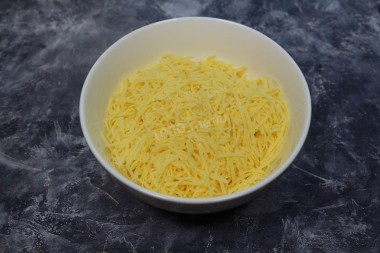
Grate the cheese. Any cheese will do, the main thing is that it is of high quality, without milk fat substitutes and melts well. As soon as the broth in the pan is absorbed, pour the grated cheese into it. Mix the cheese with the onion, remove the cheese filling from the heat and leave it to cool. The filling is ready.
Step 4:
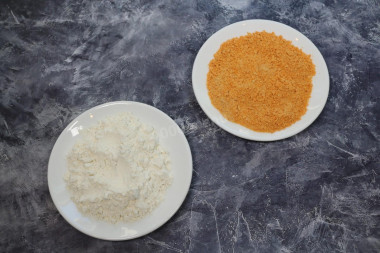
Prepare the breading. To do this, take three containers. These can be saucers or, for example, small bowls. Pour wheat flour into one container, breadcrumbs into another, and beat an egg into the third. Shake the egg lightly with a fork.
Step 5:
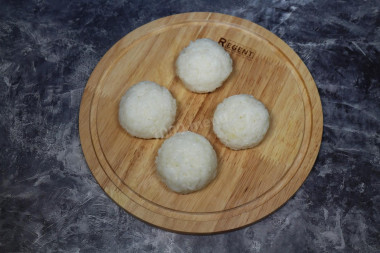
Wetting your hands in water, form balls of rice, inside of which put a filling of cheese, onion and garlic. It is convenient to do this in the palm of your hand — first put a layer of rice on it, then a spoonful of filling. Squeezing your palm, wrap the filling with rice. Roll the ball.
Step 6:
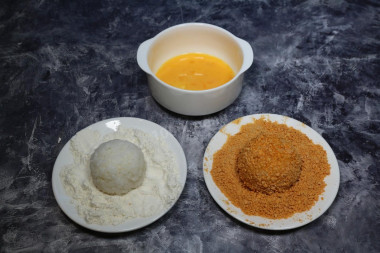
Roll each rice ball first in flour, then in beaten egg, then in breadcrumbs. Place it on a plate or cutting board. So use all the rice and cheese filling. Put the prepared rice balls in the refrigerator for 1.5 hours.
Step 7:
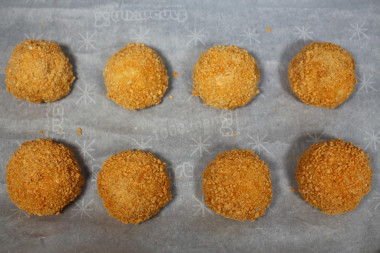
After this time, remove the balls from the refrigerator. Next, prepare the balls in any of three ways. Or fry them in butter in a frying pan, or in a large amount of vegetable deep-fried. Then put the fried balls on paper towels or napkins to get rid of excess oil. Or, as I did, bake the balls in the oven on a baking sheet covered with parchment at a temperature of 200 ° C for 25-30 minutes.
Step 8:
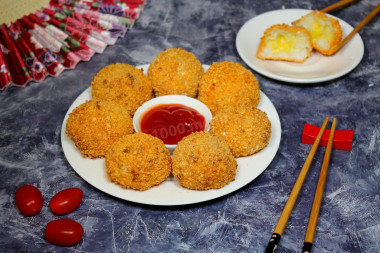
Baked in the oven, the balls turn out to be more dietary. Serve rice balls with cheese hot, with tomato or cream sauce. They also go well with fresh vegetables.
In fact, you can add any other filling to the rice balls, according to your taste. It can be, for example, vegetable, or just with cheese (to shorten the cooking time). But, of course, chicken broth makes a more interesting taste. The vegetable balls are no longer suitable for tomato, but soy sauce.
Be sure to wash the eggs before use, as even the seemingly clean shell may contain harmful bacteria. It is best to use food detergents and a brush.
Important! To make rice dishes invariably delicious, read the article about the subtleties of choosing rice and the secrets of its preparation .
Use oil with a high smoking temperature for frying! Any oils are useful only until a certain temperature is reached - the point of smoking, at which the oil begins to burn and toxic substances, including carcinogens, are formed in it.
Unrefined oils, with rare exceptions, have a low smoking point. There are a lot of unfiltered organic particles in them, which quickly begin to burn.
Refined oils are more resistant to heating, and their smoking point is higher. If you are going to cook food in the oven, on a frying pan or grill, make sure that you use oil with a high smoking point. The most common of the oils with a high smoking point: refined varieties of sunflower, olive and grape.
Caloric content of the products possible in the composition of the dish
- Onion - 41 kcal/100g
- Raw wild rice - 353 kcal/100g
- Brown raw rice - 360 kcal/100g
- Boiled brown rice - 119 kcal/100g
- White fortified raw rice - 363 kcal/100g
- Fortified boiled white rice - 109 kcal/100g
- White rice, steamed, with long grains raw - 369 kcal/100g
- Steamed white rice, boiled with long grains - 106 kcal/100g
- Instant dry rice - 374 kcal/100g
- Instant rice, ready to eat - 109 kcal/100g
- Fig - 344 kcal/100g
- Dutch cheese - 352 kcal/100g
- Swiss cheese - 335 kcal/100g
- Russian cheese - 366 kcal/100g
- Kostroma cheese - 345 kcal/100g
- Yaroslavsky cheese - 361 kcal/100g
- Altai cheese 50% fat content - 356 kcal/100g
- Soviet cheese - 400 kcal/100g
- Cheese "steppe" - 362 kcal/100g
- Uglich cheese - 347 kcal/100g
- Poshekhonsky cheese - 350 kcal/100g
- Lambert cheese - 377 kcal/100g
- Appnzeller cheese with 50% fat content - 400 kcal/100g
- Chester cheese with 50% fat content - 363 kcal/100g
- Edamer cheese with 40% fat content - 340 kcal/100g
- Cheese with mushrooms of 50% fat content - 395 kcal/100g
- Emmental cheese with 45% fat content - 420 kcal/100g
- Gouda cheese with 45% fat content - 356 kcal/100g
- Aiadeus cheese - 364 kcal/100g
- Dom blanc cheese (semi-hard) - 360 kcal/100g
- Lo spalmino cheese - 61 kcal/100g
- Cheese "etorki" (sheep, hard) - 401 kcal/100g
- White cheese - 100 kcal/100g
- Fat yellow cheese - 260 kcal/100g
- Altai cheese - 355 kcal/100g
- Kaunas cheese - 355 kcal/100g
- Latvian cheese - 316 kcal/100g
- Limburger cheese - 327 kcal/100g
- Lithuanian cheese - 250 kcal/100g
- Lake cheese - 350 kcal/100g
- Gruyere cheese - 396 kcal/100g
- Garlic - 143 kcal/100g
- Whole durum wheat flour fortified - 333 kcal/100g
- Whole durum wheat flour, universal - 364 kcal/100g
- Flour krupchatka - 348 kcal/100g
- Flour - 325 kcal/100g
- Salt - 0 kcal/100g
- Chicken egg - 80 kcal/100g
- Breadcrumbs - 347 kcal/100g
- Chicken broth - 19 kcal/100g

